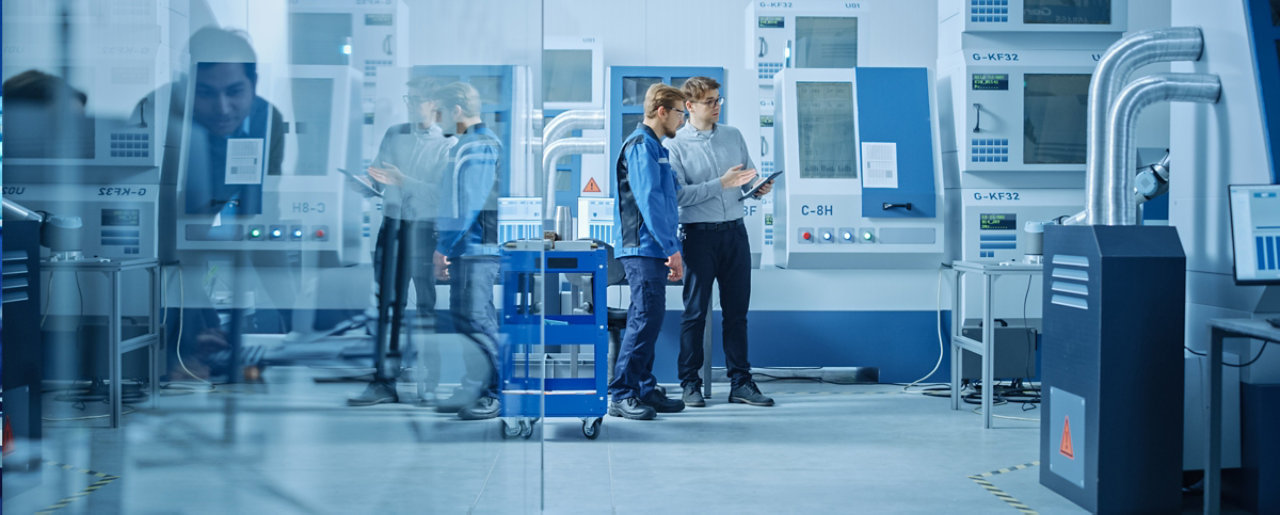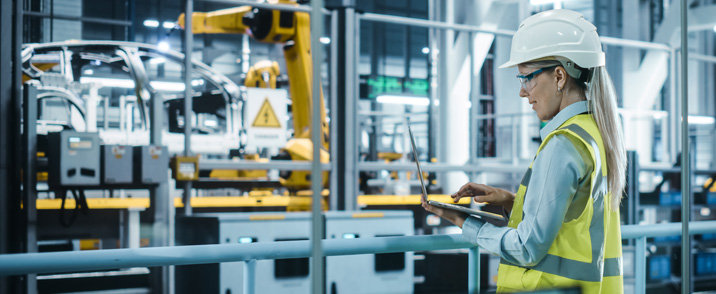A business for the future
The term ‘Internet of Things’ was first coined in 1999 by British technology pioneer Kevin Ashton to describe a system in which devices with sensors, processing ability, software and other technologies connected the internet to the physical world.
IoT communicates data with other devices over the internet and other networks to help businesses remould and become more efficient. Since 1999, IoT has been embraced by organisations across a range of industries, from automotive to manufacturing, and healthcare to agriculture.
IoT by numbers
In the race for efficiency and growth, machine to machine interactions are more important than ever. Is your business taking advantage of actionable insights from your devices and digitised processes?
83%
IoT-connected organisations reporting major increases in business efficiency – from better visibility across the organisation to easier expansion into other markets1.
34%
Brands that want to see industry-wide IoT implementation driving considerable industry growth over the next decade.
$1.15tn
Global IoT spending (hardware, connectivity, and services) by 20262.
Ofcom report
In the UK, the Ofcom Review of the latest developments in the Internet of Things report expects the number of IoT-connected devices to reach 156 million in 2024 – up from 13 million in 2016 – 70 billion things will be connected to the internet in the future.
Yet there remains a lack of understanding among many organisations and their employees about the opportunities and benefits that IoT affords.
It is imperative for businesses to educate themselves on IoT to understand the key business challenges and pain points that exist today, and how IoT can play a pivotal role in both identifying and addressing these issues.
Range of benefits
IoT can hold the key to unlocking hidden inefficiencies for organisations of all sizes, managing, monitoring, and measuring assets to inform smarter decisions. The insights IoT can provide mean organisations have greater visibility over operations, allowing them to optimise efficiency, energy output, and sustainability, plus make huge savings – especially when supported by BT’s dedicated IoT solutions.
For example, BT’s asset tracking and condition monitoring solutions provide greater visibility across the supply channel enabling businesses in the transport and logistics sector to make smarter decisions. Our remote operation IoT solutions provide real-time support through augmented, or virtual, reality helping to avoid machine downtime and delivering significant cost savings.
Condition monitoring is beneficial to property owners and managers, too. Using a single set of APIs or a simple web portal to derive data-driven insights from connected devices and sensors will help keep residents and colleagues happier and healthier by intelligently managing the environments in which they live and work.
In healthcare settings, tracking and monitoring allow medical professionals to better support the well-being of patients treated at home, by remotely monitoring their care and dispensing of medicine, while remote experts can provide clinicians with real-time assistance, regardless of where they’re located.
In manufacturing, BT’s computer vision solutions analyse real-time video data to alert firms to potential faults or production defects before they occur, giving them time to respond and avoid costly repairs. In addition, digital vision can also confirm that manufacturing teams have the right equipment and materials, thereby reducing waste and improving product quality.

Strategy for success
IoT is something that should be incorporated into an organisation’s growth or transformation strategy from the start. IoT shouldn’t be considered a sticking plaster, something that can be immediately applied to address an organisation’s inefficiencies and improve its operations and processes. Only by identifying the appropriate use cases, how IoT will be implemented, and how its impact will be measured, can it be truly beneficial to a business.
The first key questions businesses need to ask when considering the implementation of any IoT solution is what business challenge will the IoT deployment be addressing? For example, tracking assets, or monitoring processes? Once you understand the problem to be solved you can then identify what information you need to obtain to help you resolve the challenge. Without clarifying these points, it will be impossible to measure the effectiveness of a solution in addressing the particular use cases.
Another key consideration is connectivity. Nearly every enterprise now has the need to manage large estates of devices and sensors. This operational technology must be underpinned by connectivity that delivers the required performance and security at the right cost.
It’s important to remember, too, that there’s no “one size fits all” solution. Every business will have different needs, so every IoT solution will need to be tailored to fit. Indeed, that’s the beauty of IoT. Deployable in myriad ways, it’s accessible to everyone.
Finally, organisations should put people at the heart of their IoT strategy and consider how to use the technology to transform their processes to deliver the greatest possible value throughout the entire value chain. By humanising IoT in this way, businesses can take a huge step toward removing the fear factor. After all, it’s there to improve people’s jobs, not take them away.
IoT can be a significant investment. But by discovering huge savings in hidden inefficiencies, it could transform your organisation – with the support of BT’s portfolio of IoT products and solutions.
Sources
1. ‘The Internet of Things: Today and Tomorrow’ global study – Aruba (a Hewlett Packard Enterprise company)
2. IDC Worldwide Internet of Things Spending Guide



